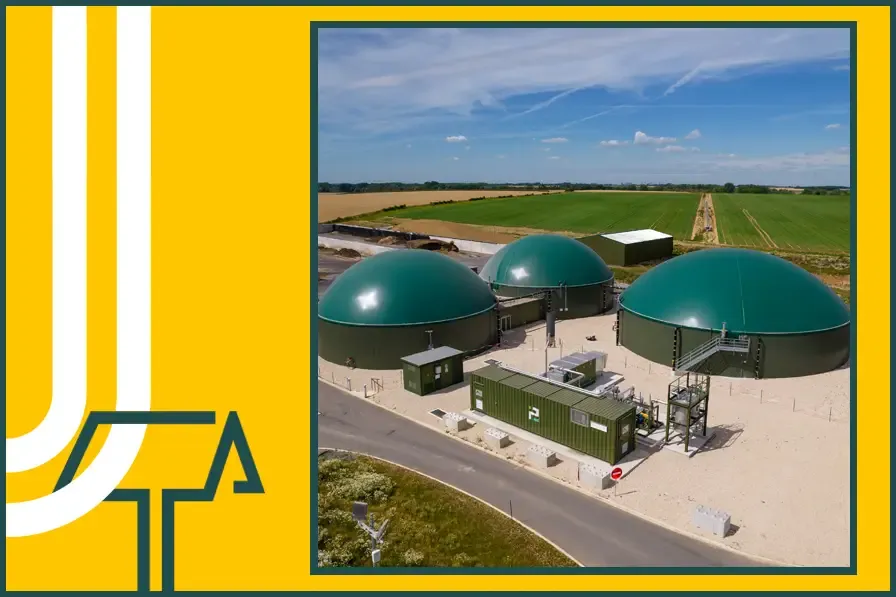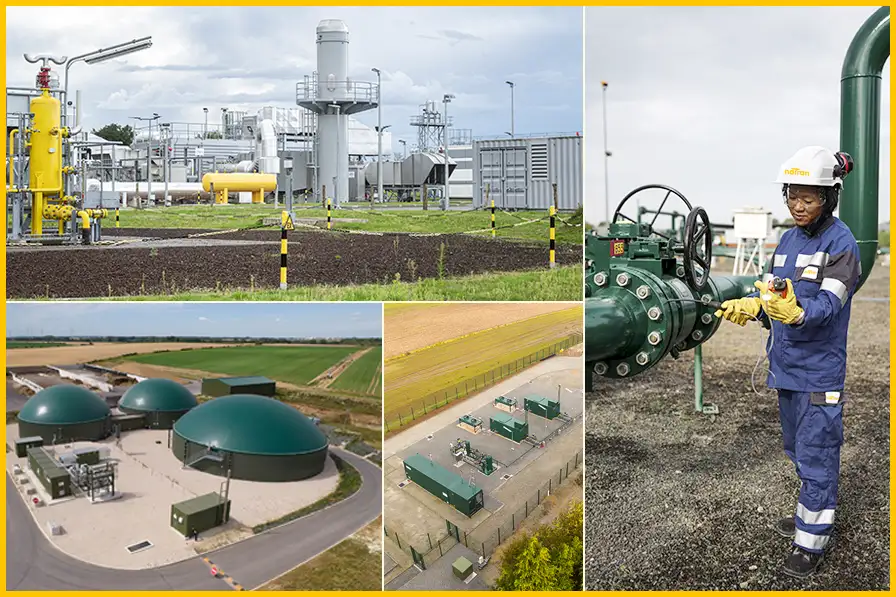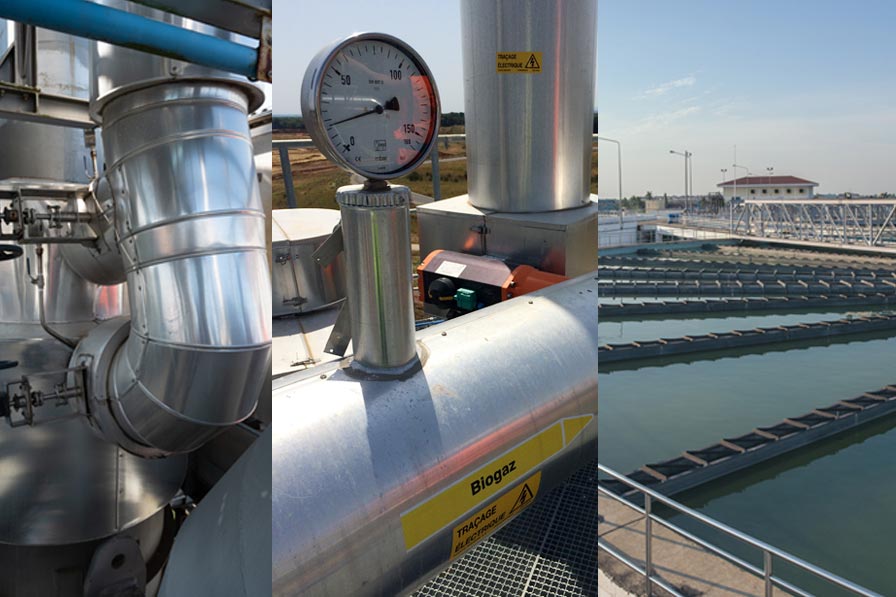From biomethane to hydrogen to CO₂… Here, we take stock of France’s gas transition

In which French region is gas consumption falling the most? Which one produces the most biomethane? And which region has the most bioNGV? Discover NaTran’s regional overview of the 2024 Gas Report.
As our latest Gas Report shows, gas consumption in France fell by 5.5% year-on-year in 2024. At the same time, the positive momentum around renewable gas was confirmed, with 11.6 TWh of biomethane injected into networks – the equivalent of two nuclear reactors. This represents 2.4 TWh more than in 2023.
Did you know that when it comes to gas consumption or renewable gas production, each region has its own characteristics and strengths? Here, we take a tour of the French regions in which NaTran operates.
Grand Est: the champion of biogas production
With 127 biogas production sites generating 2.7 TWh (+6%), the Grand Est region retains pole position in the country’s renewable energy sector. Its production represents 19.7% of all national biomethane production! Thanks to these facilities, 5.2% of the region’s total gas consumption is now supplied by biomethane, which is well above the national average (3.8%).
In parallel, the development of cross-border hydrogen transport projects is also continuing across the region. These include mosaHYc, between the Grand Est region of France and border zones in Germany and Luxembourg, which is in the process of obtaining administrative authorisations, following NaTran’s investment decision in April 2024.
Brittany: the leading consumer of biomethane
Thanks to the development of biogas and lower-than-average gas consumption, la Brittany is France’s leading renewable gas consumer, where it accounts for almost 6% of the region’s total gas consumption. Biogas production is booming: in 2024, 93 operating sites injected 23% more biomethane into networks than in 2023
Normandy: strongest growth in the biogas sector
The Normandy region is the most dynamic when it comes to biogas production, as its biomethane production capacity rose by 43% last year to 1.2 TWh. And this trend is set to continue, with 136 projects currently registered in the capacity register (+15% compared with the end of 2023).
Ile-de-France: a showcase for bioNGV mobility
With 1.45 TWh of (bio)NGV consumed in a year, l’Ile-de-France is the champion of biogas fuel consumption. The NGV (Natural Gas for Vehicles) used in the Ile-de-France region is increasingly renewable: 83% of consumption is now met by bioNGV derived from biomethane! This Parisian region also has a good supply network, with 51 refuelling points, 42 of which are available to the public.
LeFuture hydrogen and CO2 transport networks are also being prepared in the Seine Valley. As part of the ‘Hydrogen Valley’ call for projects launched by the European Union, NaTran is part of the consortium charged with studying the feasibility of a hydrogen infrastructure project between Normandy and Ile-de-France.
Hauts-de-France: fall in consumption by combined-cycle gas-fired power stations
Last year, gas consumption in the Hauts-de-France region of France fell by 12% – the second most significant regional decline. The primary cause was a very low usage of the three gas-fired power stations installed in the region (-67% compared with 2023). In terms of biomethane, the region remains in second place in France, with a production capacity of 2.3 TWh from 100 biogas production sites. This figure represents an 8% rise in one year.
The region is also positioning itself as a spearhead of industrial decarbonisation in France. To support this, NaTran launched the basic engineering studies for the DHUNE hydrogen transport prroject in Dunkirk’s industrial port zone in 2024. Meanwhile, the DKHARBO project led by NaTran and its Norwegian partner Equinor has obtained CEF (Connecting Europe Facility) subsidies from the European Union. By 2030, this structure will connect industrial sites capturing their CO2 to CO2 storage or recovery sites.
Centre-Val de Loire: 12 flow stations in the pipelines
Biomethane production continues to grow strongly in the Centre-Val de Loire region with 43 sites operating and injecting into the networks. To accommodate this local production that is constantly on the rise and to prepare for the future, a number of new flow stations* will be built. There are currently 3 in the region, but NaTran plans to build 12 more.
* The role of a flow station is to compress excess gas in local distribution areas and redirect it to the transport network. It is particularly useful during the summer, when local consumption is insufficient to absorb the biogas being produced.
Pays de la Loire: the TWh biomethane milestone is just around the corner
Here too, the biogas production sector continues to grow, with 8 new sites being commissioned in 2024. The 62 active sites injected 951 GWh into the networks. And as in the Centre-Val de Loire region, NaTran is developing a number of flow stations in Pays de la Loire to prepare for this transition: there were 4 in service in the region at the end of 2024, but 8 new stations are being planned, including three with commissioning scheduled for 2025.
reached some important milestones. Recognised as a Project of Common Interest (PCI) by the European Commission, it has obtained European funding to support basic engineering studies. Between now and 2030, GOCO2 will be focused on deploying almost 400 km of networks designed to transport CO2 captured at industrial cement and lime sites, with a view to its recovery or geological storage.
Nouvelle-Aquitaine accelerates its renewable gas production
Biomethane production in the Nouvelle-Aquitaine region has passed the TWh mark, reaching 1.1 TWh in 2024 (vs. 0.9 TWh in 2023). While 65 biogas production sites currently represent an annual capacity of 1.42 TWh, 71 additional projects have been identified that could generate an annual output of 3 TWh in around 3 years’ time. In the mobility sector, (bio)NGV confirms its position as the leading alternative fuel for heavy mobility, as in the other regions of France. Nouvelle-Aquitaine will have 34 public refuelling points by the end of 2024.
In Bourgogne-Franche-Comté, the largest agricultural biogas production plant
In September 2024, the region inaugurated France’s largest agricultural biomethane production unit called Sécalia. Launched by the Dijon Céréales cooperative and Nature Energy, it has an annual production capacity of 230 GWh – enough to meet 20% of Dijon Métropole’s gas requirements! This commissioning illustrates the excellent potential of the biogas production sector in Bourgogne-Franche-Comté.
Auvergne-Rhône-Alpes: a major ambition for 2030
Although the Auvergne-Rhône-Alpes (AURA) region is not yet a main renewable gas producer, this could change in the future. The regional target of producing 5 TWh by 2030 is one of the most ambitious out there. And let’s not forget that AURA already accounts for 23% of jobs in companies specialised in renewable and low-carbon gas. The talent is certainly there.
In the region, NaTran is also preparing the gas infrastructures of tomorrow, notably as a partner of the European IMAGHyNE project, which aims to accelerate the production of hydrogen to decarbonise industry and mobility. A 40-kilometre hydrogen transport infrastructure network is currently being studied between Lyon-Saint Exupéry airport and Lyon’s Vallée de la Chimie industrial platform, which will eventually be connected to the HY-FEN backbone.
Provence-Alpes-Côte-d’Azur: the biggest fall in consumption
Regional gas consumption in Provence-Alpes-Côte-d’Azur fell by 15% in 2024, representing the most significant drop in France! This reduction is also largely due to the reduced use of gas-fired power stations. Although the region is less favourable to agricultural biogas production, it still has potential when it comes to producing renewable gas! Seven biogas production projects are already underway, mainly involving the processing of sludge from wastewater treatment plants.
In the PACA region too, NaTran intends to drive industrial decarbonisation by bringing over 250 km of hydrogen transportation network projects to the region through HYnframed and BarMar, the latter of which aims to link the Iberian Peninsula to France and thus to the rest of Europe.
Some Top 5 figures taken from 2024 regional gas reports
Total gas consumption (TWh):
- Île-de-France : 57.6
- Grand Est : 52.9
- Hauts-de-France : 47.7
- Normandie : 38.2
- Auvergne-Rhône-Alpes : 38
Biomethane production capacity (TWh):
- Grand Est : 2.7
- Hauts-de-France : 2.3
- Normandie : 1.2
- Île-de-France : 1.2
- Nouvelle-Aquitaine : 1.1
Share of biomethane in regional gas consumption:
- Bretagne : 5.9%
- Grand Est : 5.2%
- Pays de la Loire : 5.4%
- Nouvelle-Aquitaine : 4.8%
- Hauts-de-France : 4.8%
Read more about the 2024 Gas Report

2024 in review – gas markets and the energy transition
